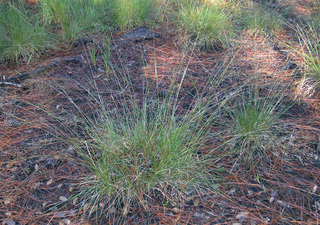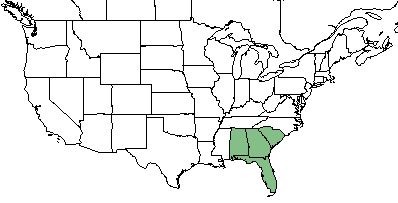Sporobolus floridanus
| Sporobolus floridanus | |
|---|---|

| |
| Photo by Bobby Hattaway hosted at Discoverlife.org | |
| Scientific classification | |
| Kingdom: | Plantae |
| Division: | Magnoliophyta - Flowering plants |
| Class: | Liliopsida - Moncots |
| Order: | Poales |
| Family: | Poaceae |
| Genus: | Sporobolus |
| Species: | S. floridanus |
| Binomial name | |
| Sporobolus floridanus Chapm. | |

| |
| Natural range of Sporobolus floridanus from USDA NRCS Plants Database. | |
Common Name(s): Florida dropseed[1]
Contents
Taxonomic Notes
Description
‘’Sporobolus floridanus’’ is a monoecious perennial graminoid.[2]
Distribution
Sporobolus floridanus is endemic to an area from southern South Carolina to peninsular Florida and west through Alabama, but the majority is found in Florida.[3] It can be found in South Carolina, Georgia, Florida, and Alabama.[1][2]
Ecology
Habitat
S. floridanus has been found in sandy pinelands, pine savannahs, marsh edges, longleaf pine-wiregrass flatwoods, and pine woodlands.[4] It is also found in disturbed areas including burned pine flatwoods and powerline corridors.[4] Associated species: Sarracenia, Macbridea, Cuphea, Verbesine chapmanii, Justicia crassifolia, Rhexia, Liatris, Carphephorus, and Helianthus angustifolius, Anthaenantia, Paspalum, Erianthus, Arnoglossum, Eupatorium, and Bigelowia, and Rhynchospora spp.[4]
S. floridanus is additionally found in wet savannas,[1], seepage bogs, and titi/cypress swamps and is abundant in wet pine savannas.[5] In north Florida mesic flatwoods S. floridanus occurred in 53% of plots with a mean coverage of 0.0613 m-2 and was the sole herbaceous indicator species this community type.[6]
Sporobolus floridanus is an indicator species for the North Florida Mesic Flatwoods community type as described in Carr et al. (2010).[7]
Phenology
S. floridanus has been observed to flower from June through September.[1][8]
Seed dispersal
This species is thought to be dispersed by gravity.[9]
Fire ecology
In Georgia, the percent cover of S. floridanus increased from 0.4% after one growing season following a burn to 1.0% after 8 growing seasons.[10]
Conservation, cultivation, and restoration
Cultural use
In the past, native peoples would harvest the tiny husk-less grains and grind them into a flour.[11]
Photo Gallery
References and notes
- ↑ 1.0 1.1 1.2 1.3 Weakley A. S.(2015). Flora of the Southern and Mid-Atlantic States. Chapel Hill, NC: University of North Carolina Herbarium.
- ↑ 2.0 2.1 USDA, NRCS. (2016). The PLANTS Database (http://plants.usda.gov, 10 January 2018). National Plant Data Team, Greensboro, NC 27401-4901 USA.
- ↑ Sorrie, B. A. and A. S. Weakley 2001. Coastal Plain valcular plant endemics: Phytogeographic patterns. Castanea 66: 50-82.
- ↑ 4.0 4.1 4.2 Florida State University Herbarium Database. URL: http://herbarium.bio.fsu.edu. Last accessed: June 2021. Collectors: L.C. Anderson and R.K. Godfrey. States and counties: Florida: Franklin, Gulf, Liberty, Nassau, Wakulla, and Walton.
- ↑ Drewa P. B., Platt W. J., and Moser E. B. (2002). Community structure along elevation gradients in headwater regions of longleaf pine savannas. Plant Ecology 160(1):61-78.
- ↑ Carr S. C., Robertson K. M., and Peet R. K. (2010). A vegetation classification of fire-dependent pinelands of Florida. Castanea 75(2):153-189.
- ↑ Carr, S.C., K.M. Robertson, and R.K. Peet. 2010. A vegetation classification of fire-dependent pinelands of Florida. Castanea 75:153-189.
- ↑ Nelson, G. PanFlora: Plant data for the eastern United States with emphasis on the Southeastern Coastal Plains, Florida, and the Florida Panhandle. www.gilnelson.com/PanFlora/ Accessed: 10 JAN 2018
- ↑ Kirkman, L. Katherine. Unpublished database of seed dispersal mode of plants found in Coastal Plain longleaf pine-grasslands of the Jones Ecological Research Center, Georgia.
- ↑ Lemon P. C. (1949). Successional responses of herbs in the longleaf-slash pine forest after fire. Ecology 30(2):135-145.
- ↑ Fernald, et al. 1958. Edible Plants of Eastern North America. Harper and Row Publishers, New York.